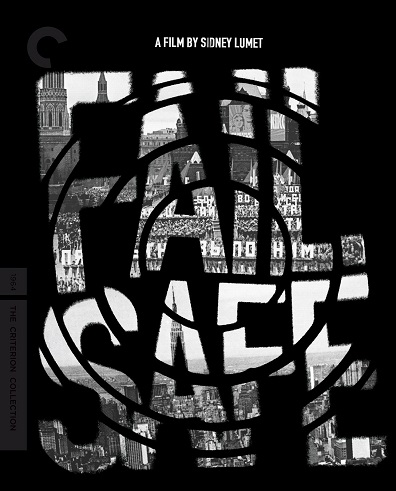
Fail Safe
Studio: The Criterion Collection
Jan 28, 2021
Web Exclusive
![]()
The Cold War was the longest collectively held breath in world history. People everywhere worried about the looming cloud of nuclear holocaust, and the art of the time highly reflected this simmering panic. Though one might think that primarily escapist entertainment would be used to distract us from the threat of the apocalypse, somehow we’re consistently gluttons for punishment. And while the Cold War hadn’t nearly reached its peak, the 1960s birthed a mass of related media that certainly could make audiences feel as if that were true.
While following a VIP tour through the Strategic Air Command headquarters, an early alert system identifies an aircraft intruding into American airspace. This plane is soon determined to be an off-course civilian airliner and the alert is squashed. However, a simultaneous computer error broadcasts faulty directives to an in-flight nuclear bomber group, instructing them to bomb Moscow. Led by the President (Henry Fonda), the SAC attempt to negate the order to prevent retaliation, though their efforts are stunted by Soviet countermeasures. When the President divulges to the leaders of the USSR that the planes are on the way, insisting they must work together to prevent atomic armageddon, the mutual distrust between the superpowers and their governmental heads runs down the clock.
The most unfortunate element about Fail Safe is its eternal comparison with Stanley Kubrick’s satiric comedy Dr. Strangelove or: How I Learned to Stop Worrying and Love the Bomb, which is due in part to the striking similarities of both films’ source materials. The similarities are so numerous, that Peter George, author of Red Alert (the source of Dr. Strangelove), sued Eugene Burdick and Harvey Wheeler, the authors of the original Fail-Safe novel, for plagiarism. But that didn’t stop Columbia Pictures purchasing the rights to both novels and releasing them in the same year—one of the weirdest distribution decisions I’ve ever seen. That would have been bad enough, but Kubrick also lobbied infamously hard to get his film released first, so ultimately Sidney Lumet’s Fail Safe stuned critically, but languished at the box office.
I have always known about this film, mainly through my deep-rooted love for all things Lumet and Kubrick, but I hadn’t taken an opportunity to see it before now. As the lawsuits between the authors and the filmmakers had proclaimed, the plots of Fail Safe and Dr. Strangelove are so similar, it baffles me that people running Columbia thought it was smart to release these within the same year, regardless of which came first. However, what distinguishes Fail Safe is its harrowingly bleak and claustrophobic tone. There are no jokes, dark or otherwise, and it approaches each character and event with deathly seriousness.
I’ve often found Lumet’s renown, as well as that of his many collaborators, comes from an explicit ability to explore characters with extreme perspective variations, but never to a caricaturistic level. These are people reacting as we all do, according to our beliefs, and our will to survive. These individuals aren’t demonized, or made to be overtly right or wrong-minded, even though nearly every character makes a massive mistake in judgement which contributes to the emphatically nihilistic ending.
Fail-Safe’s home distribution has been varied over the years. While first appearing on CBS television in 1966, it had a VHS release in the early ‘80s and a DVD in 2000. The recent Blu-ray restoration and release by The Criterion Collection marks the first high definition home release of the film. The 4K digital scan with the original uncompressed audio is paired up with a deeply fascinating commentary from Sidney Lumet, recorded for the original ‘00 DVD. An interview with the stalwart film critic J. Hoberman, on Cold War paranoia and its films, is buttressed by “Fail Safe” Revisited, a short 2000 featurette by the powerhouse documentarian Jeffrey Schwarz. This small docu includes exclusive interviews with Lumet, screenwriter Walter Bernstein, and actor Dan O’Herlihy. This is all topped off by “Very Little Left in the World,” a printed essay (in the shape of two nuclear bombs) by critic and filmmaker Bilge Ebiri, whose excellent writing captures every essence of the film from both an analytical perspective, as well as contextual.
While Dr. Strangelove certainly seemed to impact the zeitgeist more widely than Fail-Safe, this film also stands the test of time as a bleak and unrelenting reminder how close we still ride to the edge of oblivion. These soldiers, leaders, and their families are just people, and we all make mistakes, and sometimes those mistakes have the best of intentions. But Fail-Safe does not reward those actions, even if the filmmakers agreed with any specific character, for the consequences of any action are largely unpredictable, and always final.
(www.criterion.com/films/28825-fail-safe)
Current Issue

Issue #72
Apr 19, 2024 Issue #72 - The ‘90s Issue with The Cardigans and Thurston Moore
Most Recent
- 10 Best Songs of the Week: Nilüfer Yanya, Linn Koch-Emmery, Fat Dog, Crumb, St. Vincent, and More (News) —
- Fat Dog Announce New Album and Tour, Share Video for New Song “Running” (News) —
- The Obsessed, Howling Giant @ Brooklyn Meadows, NYC, April 12, 2024 (Review) —
- Premiere: Slow Joy Releases New Single and Video for “King Cowboy” (News) —
- Premiere: Mackenzie Shrieve Shares New Single “Didn’t I Tell Ya” Feat. Jane Bruce (News) —

Comments
Submit your comment
There are no comments for this entry yet.